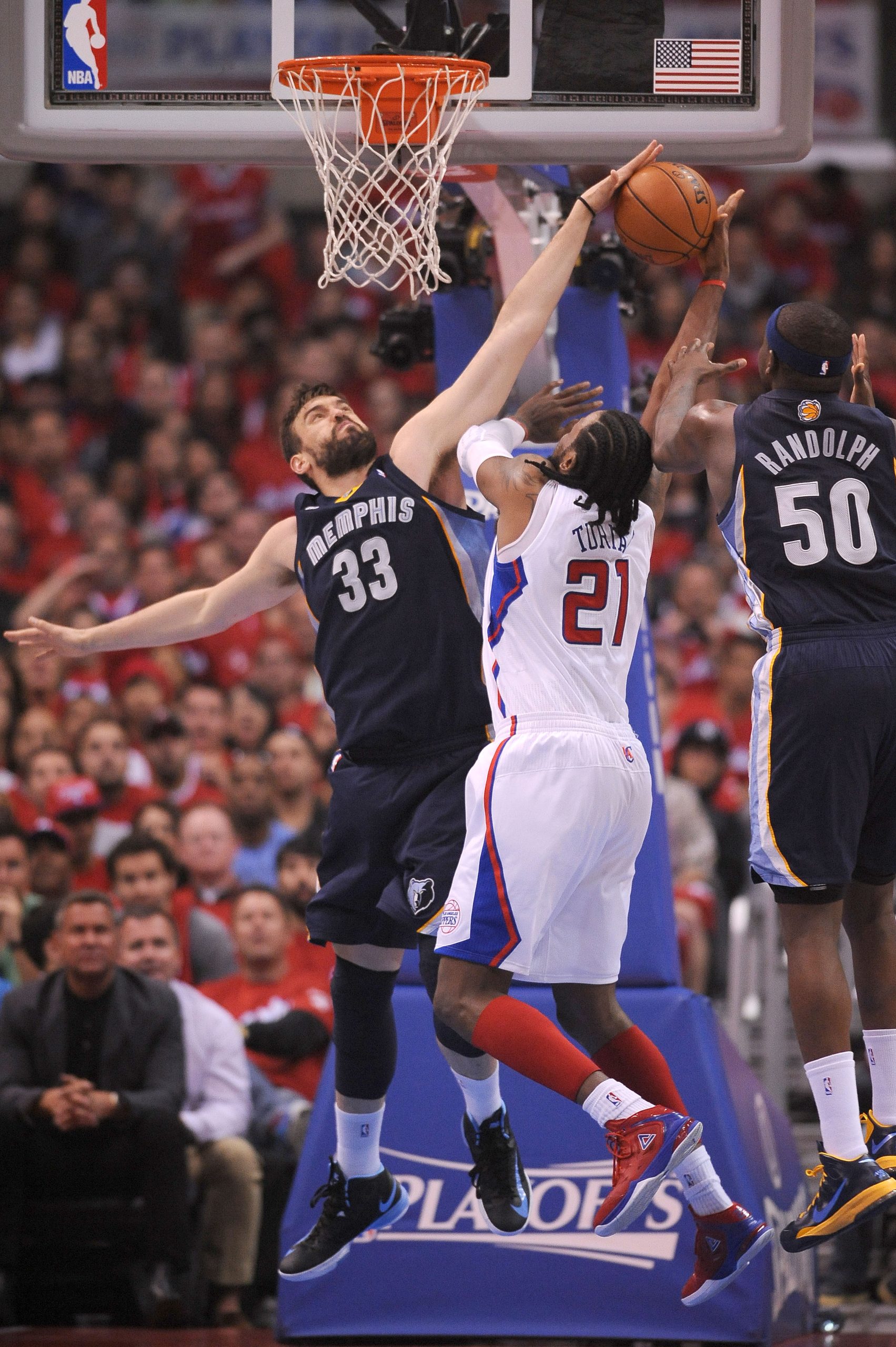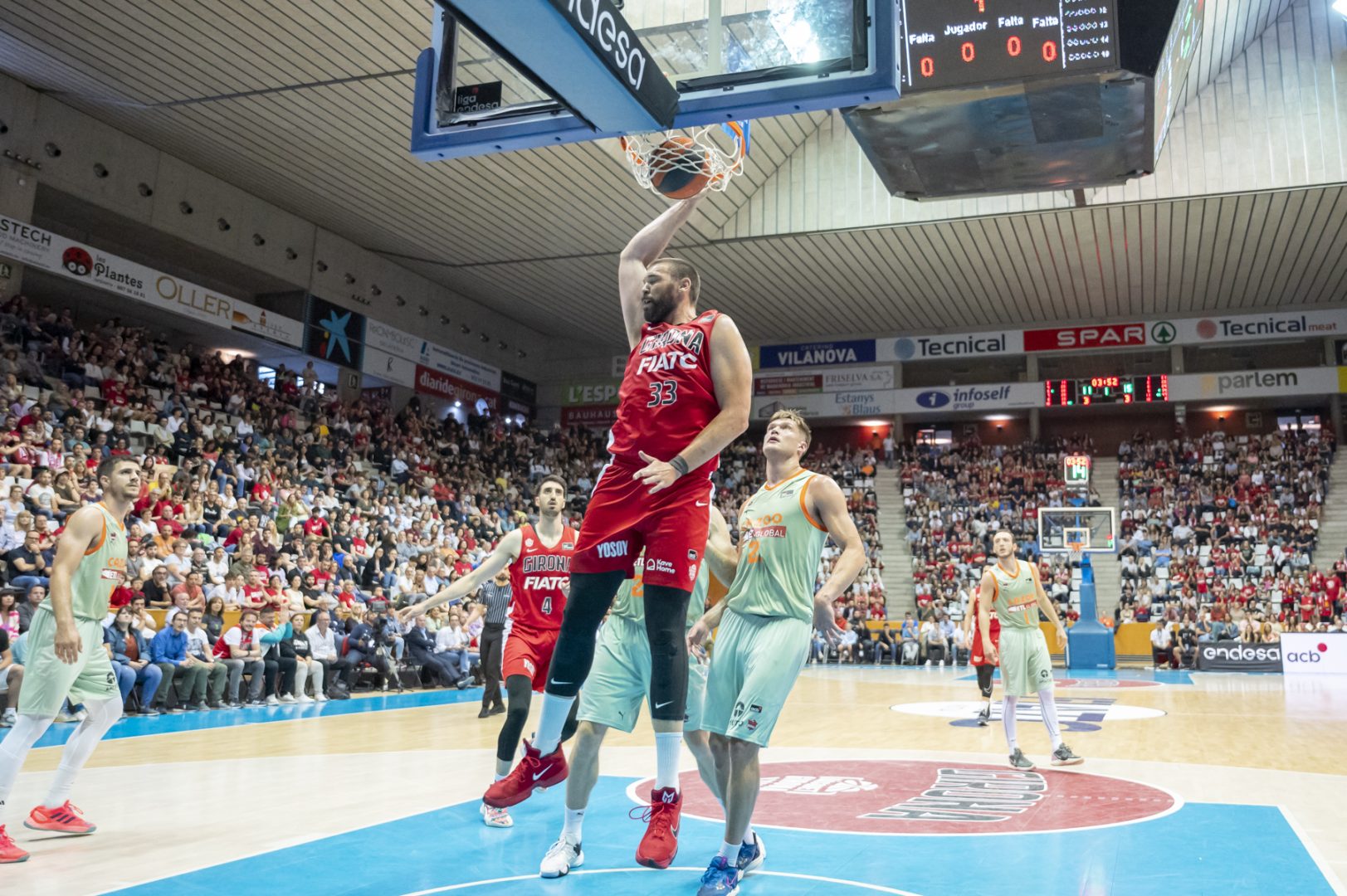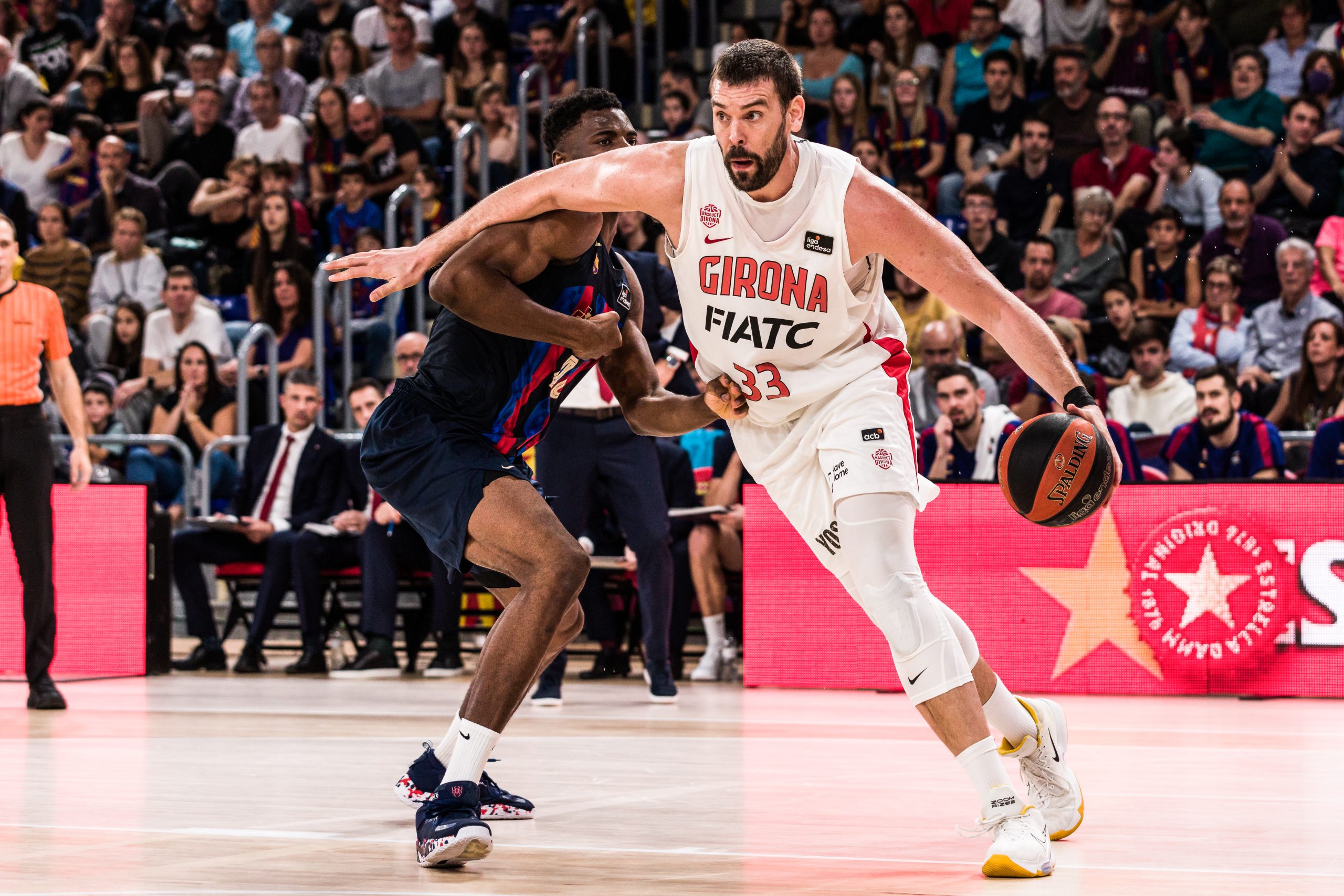Marc Gasol is Entering a New Chapter as Both Player and Owner of Spanish Basketball Club, Bàsquet Girona
In the NBA, it was easy enough to differentiate between the two Gasols. Pau arrived as a top pick, clean-cut, lithe, good for 18 and 10 from Day 1. Marc, a second-rounder, debuted seven years later, a bearded, barrel-chested enforcer. Sure, they were both Grizzlies and exquisite passers at 7-0, but beside the League’s twin teammates and sibling trios, each Gasol seemed totally distinct.
In Girona, Spain, however, things are getting a little confusing. This delightful medieval city, located an hour north of Barcelona, technically has only one Gasol brother: Marc. But within him are two alter egos: Marc the owner of Bàsquet Girona, and Marc the star player of—yes—Bàsquet Girona. Indeed, the 38-year-old is making history as (probably) the first-ever player-owner in pro hoops. But it’s not easy keeping it all together. Gasol shifts back and forth between the two personas each day, and even during conversation. Marc the owner is an optimistic neophyte; Marc the player is a fiery veteran back in Girona after a 13-year hiatus.
“They don’t deal well with each other,” Gasol says. The owner’s goal is to expand Bàsquet Girona’s long-term impact beyond hoops. The player? “I’m 38. There is no tomorrow,” he says. “I’m very calm and reflective inside the front office, but on the court it’s the complete opposite. Not allowing one cup to spill into the other is a challenge. But that’s what I chose.”
This experiment began in 2014, when Gasol founded the Bàsquet Girona youth academy. The team came next, in 2017, after its prior iteration had gone belly-up under different ownership. Gasol joined as a player in 2021 following his NBA retirement. Immediately, he played hero, adding two more distinctions to his title: founder-owner-president-player-reigning champ-reigning MVP. (On LinkedIn, he is simply “President, Bàsquet Girona.” Pau is Vice President, a job he serves remotely.)
Why Girona? It’s not Gasol’s hometown (that’s Sant Boi de Llobregat, a province in Barcelona), but it is where his career first blossomed. “The way the city embraced me and helped me become a basketball player was something that impacted me. I wanted more players to feel the warmth and security of a city behind them,” he says.
In turn, Gasol has given Girona all the warmth and security he can muster. The team is on solid footing, the youth academy has grown to 450 boys and girls, and around town Gasol is omnipresent, easily spotted at coffee shops and sustainability council meetings.
“Everybody in Girona loves Marc,” a local journalist named Nil Solà says. “Here, everything is Marc.”

This love story began some 17 years ago. Back then, it was simple: Girona gave Gasol a chance to play basketball. He was 21 when then-CB Girona acquired him from Barcelona Bàsquet, where he rarely played.
Gasol has repaid that favor time and time again.
In 2007, his NBA stock began to climb, but he declined to travel for pre-draft workouts, content in Girona. “I didn’t care,” he says. He was drafted by the Lakers in the second round and stayed put. A few months later, Barcelona asked for a mulligan on the loan that had sent Gasol to Girona in the first place. Gasol personally called Barcelona’s front office to veto the deal. “I said, I’m staying in Girona.”
Gasol’s NBA rights were soon traded from Los Angeles to Memphis in the notoriously lopsided deal for Pau, which even Marc calls “a rip-off.” The NBA world was disgusted. Gasol could not have cared less. He remained in Girona and won MVP of Liga ACB, Spain’s top division. But amid the global financial meltdown, CB Girona went into disarray. Finally, Gasol left for the NBA.
In Memphis, he anchored the upstart Grit ’N Grind Grizzlies, countering the League’s chaotic three-point revolution with a polished bruising style. In 2013, he was named Defensive Player of the Year while leading all centers in assists. In 2015, he inked a max extension—five years, $100 million. He used some of the money to finance the Bàsquet Girona youth academy, and founded the men’s team within two years.

It debuted in Spain’s fourth division in 2017. Gasol kept tabs from Memphis, and then Toronto, where he landed in a mid-season trade that ended with a ring and the Raptors first-ever NBA Championship. By 2021, Bàsquet Girona had clawed its way up the Spanish ranks, reaching second-division LEB Gold. A promotion back to the ACB was just one great season away, but further relegation was also just one awful season away. The team opened at 2-7. Gasol had a choice to make: extend his NBA career, or cut it short to save hoops in Girona.
“I’m a person that looks in the mirror,” he says. During the ’20-21 season, Gasol had been a 36-year-old reserve on the Lakers, donning purple and gold in “awkward” fashion by his own admission. Still, he labored over whether to return to Girona. “We tend to remember only the good things about places,” he says. “Sometimes those memories are better to stay untouched.”
Gasol is seated along the baseline at Pavelló Girona-Fontajau, home to so many of those memories. It’s a modest stadium—gray, low-slung, about a 25-minute walk from the city’s striking old town. The gym has a YMCA feel, its halls filled with backpack-clad academy kids. As I chat with Gasol, practice begins for Uni Girona CB, a dominant force in Liga Femenina, the ACB’s women’s counterpart. Gasol became a star on this floor, and during his lengthy hiatus hardly anything here changed. Not even the scoreboard hanging above us, he says. Offering no stats nor in-game entertainment, it is practically a symbol of resistance against the NBA’s piped-in, gambling-crazed atmosphere. Gasol’s final NBA game had been at the STAPLES Center, which once threw an unveiling ceremony for its $10 million jumbotron. Well, good for the STAPLES Center. The rest of Gasol’s home games, he decided, should be spent here instead.
“This is something I always wanted to do before I say goodbye to this sport and to the court, to play here one more time,” Gasol says.
On December 3, 2021, he returned to this floor after 13 years away.

At first, Gasol’s intention was merely to play well enough to stabilize his organization. “When you’re not playing well on the court, it creates an insecurity feeling everywhere else,” he says, clearly speaking as Marc the owner. “I didn’t want what happens on the floor to have an impact on everybody’s mood in the office.”
But Marc the owner doesn’t play basketball, and Marc the player is a competitive freak. If Gasol had looked washed up in Los Angeles, he was an instant force in Girona. He averaged just shy of 15 points, 10 boards and 3 assists in his return season—a near-replica of his MVP campaign 14 years earlier—and was named MVP of LEB Gold. Bàsquet Girona swept through the playoffs (Gasol gutted out a knee injury in the finals because of course he did), earning a promotion back to Liga ACB.
Glory had been properly restored to the once-defunct franchise.
The mission was complete.
Or was it?
No, no—instead, the heroism of Marc the player kicked Marc the owner into a new competitive gear. Heading into this season, Girona’s first in the ACB since ’08, he strengthened the organization from top to bottom. He expanded the club’s staff to 130. He acquired three new starters, including Kameron Taylor, a 6-6 wing who leads the team in scoring. He hired 76-year-old coach Aíto García Reneses, winner of nine—count ’em—ACB titles and the 2008 Olympic silver medal. And, best of all, he had an ACB rule barring player-presidents overturned.
Local excitement erupted: season tickets sold out within 24 hours. (The team is nearing self-sustainability—where once Gasol financed the organization entirely out of pocket, he now covers less than 10 percent of costs, including his own minimum contract, and team revenue accounts for the rest.)

Still, facing ACB competition has been a challenge. A few hours after I sit down with Gasol, Bàsquet Girona struggles against Bàsquet Manresa, a relegation candidate. Gasol receives a raucous ovation during lineup introductions, but on the floor looks his age. He moves slowly and defers often, playing the role of safety valve rather than superstar (or overbearing owner). In fairness, Gasol was a slow-mover and willing teammate in his prime, too.
“He’s a guy that likes to see others do well,” says Taylor. “You would think at his age, with his years in the NBA, and being the owner of the team, he’d come out here and expect the ball every time. But he’s out here sweating like the rest of us. He’s not the owner when he’s playing basketball.”
Gasol finishes with 13 points as Bàsquet Girona loses. At 8-16, the team is merely three games clear of relegation. They ultimately finished the season 11-23, one skinny game above relegation. Is this struggle a wrench in Gasol’s Hollywood story, or the essence of it? Over a few days in Girona, I come to see it as the latter.
If Gasol could score at will and assure victory, there would be no need to separate the two Marcs. Winning would unify the big-picture thinker and the urgent competitor within him. It’s the losses that necessitate the divide and underscore the challenge at hand.
After each loss, Gasol says, “As soon as I take a shower and walk down the hall, I need to change completely,” embodying the patient owner over the frustrated player. Or at least that’s the idea. In reality, no Gasol ever stays boxed out for long.
“I’m trying to change the narrative of, only winning and losing matters,” Marc the owner says, but Marc the player rejects that notion and cuts in. “Obviously, for me, winning means more than anything,” he says. The owner interjects: “But there’s a lot more to it.” And on and on they go.
Photos via Getty Images and Segi Geronès.